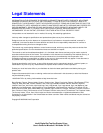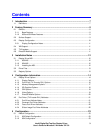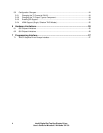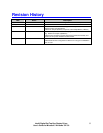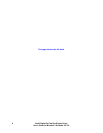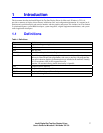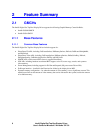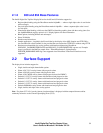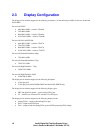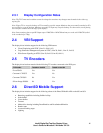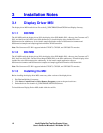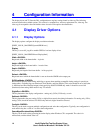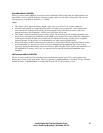Intel® Digital Set Top Box Display Driver 9
User’s Guide for Microsoft* Windows* CE 5.0
2.1.2 830 and 854 Base Features
The Intel® Digital Set Top Box Display Driver for the 830 and 854 includes support for:
• Region alpha blending using the DirectDraw method AlphaBlt — where a single alpha value is used for the
entire rectangle.
• Per-pixel alpha blending using the DirectDraw method AlphaBlt — where a separate alpha value is used
for each pixel.
• Plane based alpha blending, which uses the GMCH to blend the graphics plane with the overlay plane. See
the AlphaBlendMode registry option in
4.1.1 Display Options for more information.
• Blend options, including bilinear and anisotropic.
• Direct 3D Mobile
• Hardware anti-aliased text
• Sample applications – installed in the Extras folder by the display driver MSI. Samples are CETK DLLs.
An executable file called TestShell is also provided that can execute the CETK DLLs without using CETK.
• Hardware-accelerated bob for overlay surfaces with interleaved data using DirectDraw
(DDCAPS2_CANBOBINTERLEAVED and DDCAPS2_CANFLIPODDEVEN caps are set). Example
usage is provided in the BobTest sample. Note: IDirectDrawSurface5::UpdateOverlay
DDOVER_BOBHARDWARE flag is not supported since DirectDraw Video Port Extensions are not
supported.
2.2 Surface Support
The display driver includes support for:
• Single, double and triple frame buffer options
• Planar 4:2:0 YV12 overlay format with progressive data
• Planar 4:2:0 I420 overlay format with progressive data
• Planar 4:2:0 CMWH overlay format with progressive data (for HWMC)
• Packed 4:2:2 YUY2 overlay format with interleaved and progressive data
• Packed 4:2:2 UYVY overlay format with interleaved and progressive data
• Packed 4:2:2 YVYU overlay format with interleaved and progressive data
• Packed 4:2:2 VYUY overlay format with interleaved and progressive data
• Packed xRGB8888 overlay format with interleaved and progressive data
• Single, double, and triple video overlay options
Note: For planar YUV 4:2:0 overlay formats, interleaved data is displayed with the temporal chroma artifact
commonly referred to as the Chroma Upsampling Error (CUE).




